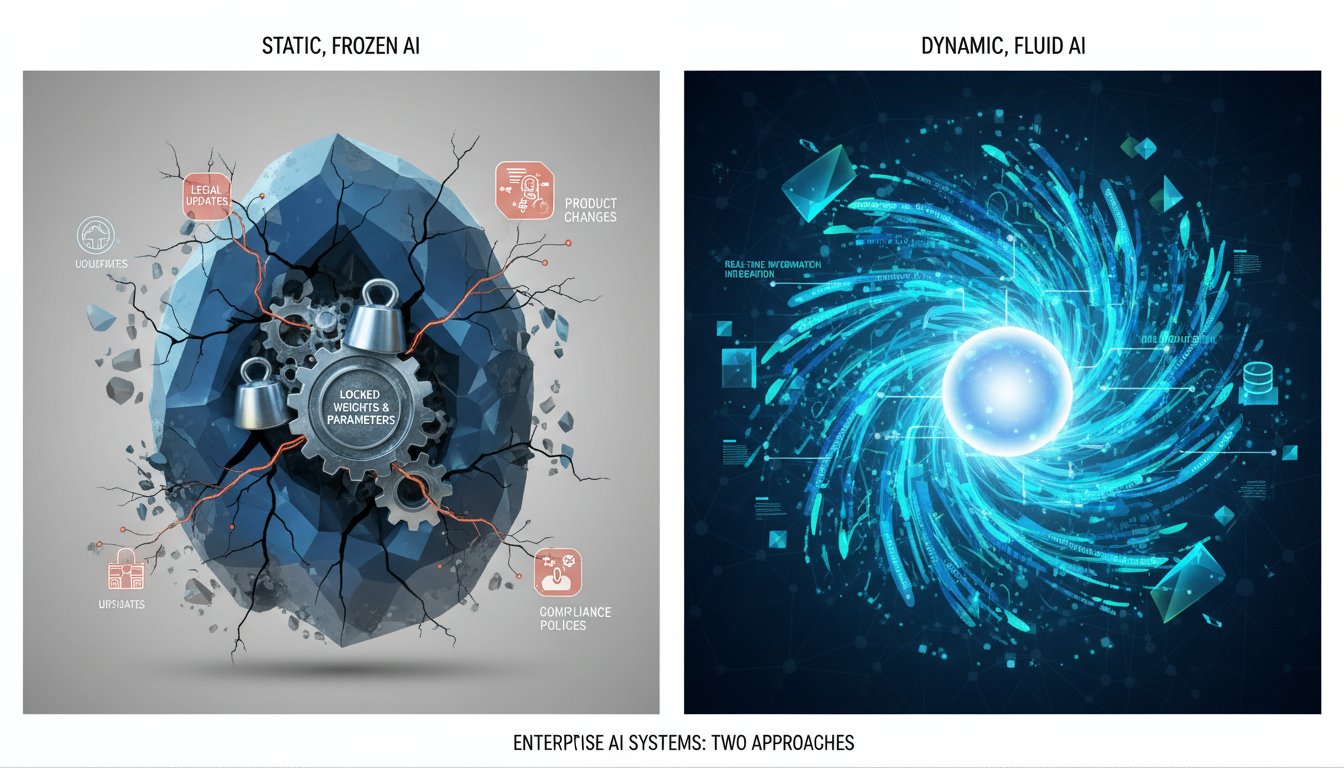The enterprise AI landscape has a dirty secret: most RAG systems never make it past the proof-of-concept stage. According to recent industry surveys, 73% of organizations struggle to scale their retrieval-augmented generation systems from prototype to production. The culprit? Infrastructure complexity, unpredictable costs, and the nightmare of managing vector databases at scale.
But what if there was a way to eliminate these barriers entirely? Pinecone’s new serverless architecture promises to do exactly that, offering a paradigm shift that could finally unlock enterprise-grade RAG deployment for organizations of all sizes. This isn’t just another incremental improvement—it’s a fundamental reimagining of how vector databases should work in production environments.
In this comprehensive guide, we’ll walk through building a complete production-ready RAG system using Pinecone’s serverless infrastructure. You’ll learn how to leverage automatic scaling, pay-per-use pricing, and zero-maintenance operations to create a system that can handle everything from startup prototypes to enterprise-scale deployments. By the end, you’ll have a blueprint for implementing RAG systems that actually make it to production—and stay there.
Understanding Pinecone’s Serverless Revolution
Pinecone’s serverless architecture represents a fundamental shift from traditional vector database management. Unlike pod-based systems that require capacity planning and manual scaling, serverless infrastructure automatically adjusts to your workload demands in real-time.
The Technical Foundation
The serverless model operates on a consumption-based pricing structure where you pay only for the operations you perform—reads, writes, and storage. This eliminates the need for pre-provisioning capacity and dramatically reduces operational overhead.
Key technical advantages include:
- Automatic scaling: The system scales from zero to millions of vectors without intervention
- Cold start optimization: Sub-second query responses even after periods of inactivity
- Multi-region replication: Built-in disaster recovery and global distribution
- Managed infrastructure: Zero database administration or maintenance required
Performance Benchmarks
Recent performance tests show serverless Pinecone achieving query latencies under 100ms for 95% of requests, even with indexes containing over 10 million vectors. The system maintains consistent performance across varying load patterns, automatically allocating resources based on demand.
Architectural Design for Enterprise RAG Systems
Building a production-ready RAG system requires careful consideration of data flow, security, and scalability requirements. The serverless model simplifies many traditional concerns while introducing new design patterns.
Core System Components
A robust enterprise RAG architecture consists of several interconnected layers:
Data Ingestion Layer: Handles document processing, chunking, and embedding generation. This layer must accommodate various file formats while maintaining data lineage and version control.
Vector Storage Layer: Pinecone’s serverless infrastructure provides the foundation for similarity search operations. The serverless model eliminates capacity planning while ensuring consistent performance.
Retrieval Engine: Implements sophisticated search strategies including hybrid search, re-ranking, and contextual filtering. Modern implementations often combine vector similarity with traditional keyword matching.
Generation Layer: Integrates with large language models to synthesize responses based on retrieved context. This layer requires careful prompt engineering and response validation.
Security and Compliance Considerations
Enterprise deployments must address stringent security requirements:
- Data encryption: All data remains encrypted in transit and at rest
- Access controls: Role-based permissions and audit logging
- Compliance frameworks: SOC 2, GDPR, and industry-specific requirements
- Network isolation: VPC connectivity and private endpoint support
Implementation Guide: Building Your RAG System
Let’s walk through implementing a complete RAG system using Pinecone’s serverless architecture. This implementation will handle document ingestion, vector storage, and intelligent retrieval.
Setting Up the Foundation
Start by establishing your development environment and dependencies:
import pinecone
from pinecone import Pinecone, ServerlessSpec
from langchain.text_splitter import RecursiveCharacterTextSplitter
from langchain.embeddings import OpenAIEmbeddings
from langchain.llms import OpenAI
import os
# Initialize Pinecone client
pc = Pinecone(api_key=os.getenv("PINECONE_API_KEY"))
# Create serverless index
index_name = "enterprise-rag-index"
pc.create_index(
name=index_name,
dimension=1536, # OpenAI embedding dimension
metric="cosine",
spec=ServerlessSpec(
cloud="aws",
region="us-east-1"
)
)
Document Processing Pipeline
Implement a robust document processing system that can handle various file formats while maintaining data quality:
class DocumentProcessor:
def __init__(self):
self.text_splitter = RecursiveCharacterTextSplitter(
chunk_size=1000,
chunk_overlap=200,
separators=["\n\n", "\n", ".", "!", "?", ",", " ", ""]
)
self.embeddings = OpenAIEmbeddings()
def process_document(self, document_path, metadata=None):
# Extract text from document
text = self.extract_text(document_path)
# Split into chunks
chunks = self.text_splitter.split_text(text)
# Generate embeddings
embeddings = self.embeddings.embed_documents(chunks)
# Prepare vectors for Pinecone
vectors = []
for i, (chunk, embedding) in enumerate(zip(chunks, embeddings)):
vector_id = f"{document_path}_{i}"
vector_metadata = {
"text": chunk,
"source": document_path,
"chunk_index": i,
**(metadata or {})
}
vectors.append((vector_id, embedding, vector_metadata))
return vectors
Advanced Retrieval Strategies
Implement sophisticated retrieval methods that go beyond simple similarity search:
class AdvancedRetriever:
def __init__(self, index_name):
self.index = pc.Index(index_name)
self.embeddings = OpenAIEmbeddings()
def hybrid_search(self, query, filters=None, top_k=10):
# Generate query embedding
query_embedding = self.embeddings.embed_query(query)
# Perform vector search
results = self.index.query(
vector=query_embedding,
top_k=top_k * 2, # Get more results for re-ranking
include_metadata=True,
filter=filters
)
# Re-rank results using additional criteria
reranked_results = self.rerank_results(query, results.matches)
return reranked_results[:top_k]
def rerank_results(self, query, results):
# Implement custom re-ranking logic
# Consider factors like recency, authority, relevance
scored_results = []
for result in results:
base_score = result.score
text = result.metadata.get('text', '')
# Calculate additional scoring factors
length_score = min(len(text) / 500, 1.0) # Prefer longer chunks
keyword_score = self.calculate_keyword_overlap(query, text)
# Combine scores
final_score = (base_score * 0.7 +
length_score * 0.2 +
keyword_score * 0.1)
scored_results.append((result, final_score))
# Sort by final score
scored_results.sort(key=lambda x: x[1], reverse=True)
return [result for result, score in scored_results]
Production Deployment Considerations
Moving to production requires attention to monitoring, error handling, and performance optimization:
class ProductionRAGSystem:
def __init__(self, index_name):
self.retriever = AdvancedRetriever(index_name)
self.llm = OpenAI(temperature=0.1)
self.metrics_collector = MetricsCollector()
async def generate_response(self, query, user_id=None):
try:
start_time = time.time()
# Retrieve relevant context
context_docs = self.retriever.hybrid_search(
query,
filters={"user_access": user_id} if user_id else None
)
# Prepare context for LLM
context = "\n\n".join([doc.metadata['text'] for doc in context_docs])
# Generate response
prompt = self.build_prompt(query, context)
response = await self.llm.agenerate([prompt])
# Log metrics
self.metrics_collector.record_query(
query=query,
response_time=time.time() - start_time,
context_docs=len(context_docs),
user_id=user_id
)
return {
"response": response.generations[0][0].text,
"sources": [doc.metadata['source'] for doc in context_docs],
"confidence": self.calculate_confidence(context_docs)
}
except Exception as e:
self.metrics_collector.record_error(str(e), query)
raise
Scaling and Performance Optimization
Serverless infrastructure provides automatic scaling, but optimization strategies can significantly improve performance and reduce costs.
Embedding Strategy Optimization
Choose embedding models based on your specific use case requirements:
- General purpose: OpenAI text-embedding-ada-002 offers excellent balance of quality and cost
- Domain-specific: Fine-tuned models for specialized content (legal, medical, technical)
- Multilingual: Models optimized for cross-language retrieval
- Large context: Newer models supporting longer input sequences
Query Optimization Patterns
Implement caching and query optimization strategies:
class OptimizedQueryHandler:
def __init__(self):
self.cache = RedisCache()
self.query_optimizer = QueryOptimizer()
async def process_query(self, query):
# Check cache first
cache_key = self.generate_cache_key(query)
cached_result = await self.cache.get(cache_key)
if cached_result:
return cached_result
# Optimize query for better retrieval
optimized_query = self.query_optimizer.enhance_query(query)
# Process with fallback strategies
result = await self.process_with_fallbacks(optimized_query)
# Cache successful results
await self.cache.set(cache_key, result, ttl=3600)
return result
Cost Management Strategies
Serverless pricing requires different optimization approaches:
- Batch operations: Group related updates to minimize API calls
- Selective indexing: Index only high-value content based on usage patterns
- Query routing: Direct simple queries to faster, cheaper alternatives
- Cache strategically: Implement multi-layer caching for frequently accessed data
Monitoring and Maintenance
Production RAG systems require comprehensive monitoring and proactive maintenance strategies.
Essential Metrics
Track key performance indicators that matter for RAG systems:
- Query latency: P50, P95, P99 response times
- Retrieval accuracy: Relevance scores and user feedback
- System availability: Uptime and error rates
- Cost efficiency: Cost per query and resource utilization
- User satisfaction: Response quality ratings and usage patterns
Automated Quality Assurance
Implement automated testing for continuous quality validation:
class RAGQualityMonitor:
def __init__(self, test_queries_path):
self.test_queries = self.load_test_queries(test_queries_path)
self.quality_threshold = 0.8
async def run_quality_checks(self):
results = []
for test_case in self.test_queries:
query = test_case['query']
expected_sources = test_case['expected_sources']
# Run query through system
response = await self.rag_system.generate_response(query)
# Evaluate quality
quality_score = self.evaluate_response_quality(
query, response, expected_sources
)
results.append({
'query': query,
'quality_score': quality_score,
'response': response,
'timestamp': datetime.utcnow()
})
# Alert if quality drops below threshold
avg_quality = sum(r['quality_score'] for r in results) / len(results)
if avg_quality < self.quality_threshold:
await self.send_quality_alert(avg_quality, results)
return results
Future-Proofing Your RAG Architecture
As the AI landscape evolves rapidly, designing for adaptability ensures long-term success.
Emerging Patterns
Stay ahead of industry trends that will shape RAG systems:
- Multimodal RAG: Integration of text, images, and audio in unified systems
- Federated learning: Distributed model training across organizations
- Edge deployment: Moving inference closer to data sources
- Specialized models: Domain-specific LLMs for improved accuracy
Integration Readiness
Design your system to accommodate future integrations:
- API-first architecture: Well-defined interfaces for easy extension
- Modular components: Swappable embedding models and LLMs
- Configuration management: External configuration for rapid adaptation
- Version management: Support for A/B testing and gradual rollouts
Building a production-ready RAG system with Pinecone’s serverless architecture represents more than just a technical implementation—it’s a strategic investment in your organization’s AI capabilities. The serverless model eliminates traditional barriers to scaling while providing the reliability and performance required for enterprise applications.
The architecture we’ve outlined handles everything from document ingestion to intelligent response generation, with built-in monitoring and quality assurance. By leveraging serverless infrastructure, you can focus on delivering value rather than managing databases, while automatic scaling ensures your system grows with your needs.
Ready to transform your organization’s approach to information retrieval and generation? Start with a pilot implementation using the patterns described in this guide, then gradually expand to cover your entire knowledge base. The combination of Pinecone’s serverless technology and thoughtful system design will position your RAG system for long-term success in production environments.




